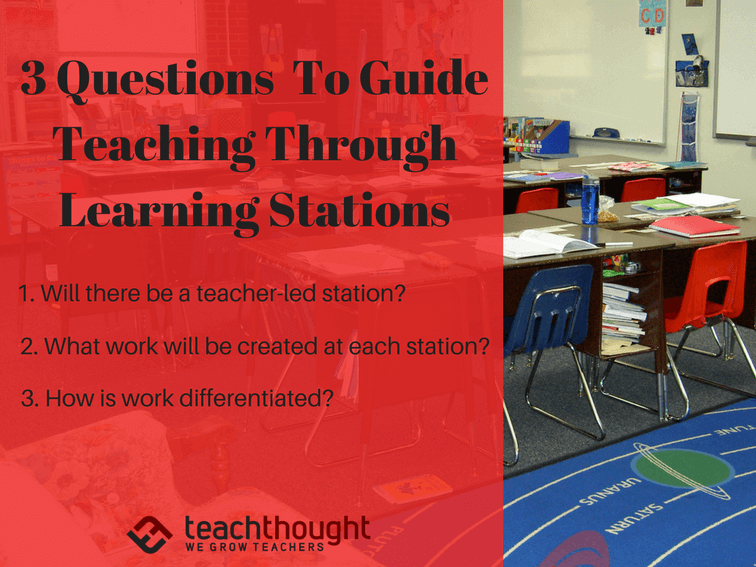
How To Guide Teaching Through Learning Stations
contributed by Suzy Pepper Rollins, myedexpert.com
This is sponsored content
Learning stations can be a dynamic, highly effective instructional device.
In fact, they can be a thing of beauty to observe. At one station, students collaborate on a piece of writing. At another, learners sit on the floor, engaged in a vocabulary sort. At station three, a teacher works with a small group of students, shoring up missing pieces or exploring new content.
Technology integration is often employed, even in rooms with just a handful of devices. As a buzzer signals, students pack up and move to the next center where a different task awaits them. At their best, stations encourage student autonomy, critical thinking, collaboration, and student engagement.
In text-based classes, they can also serve to break up readings into smaller pieces and provide opportunities for differentiation by readiness and interest. In math, students can roll a cube with six problems, debate math concepts in a fact or fib, or watch a math video.
In science, labs and math applications can be interwoven; in health, an analysis of food packaging might be included. Breaking the class period up into time segments for stations can also mirror attention spans. By the time students get restless, it’s often time to move on to something new and different.
For all their potential strengths; however, learning stations can also pose some instructional issues. When I first started doing classroom walks, my enthusiasm for seeing students so happily engaged in their station work often became tempered with classroom data that did not square with my observations. How could learners be so busily engaged and not reach their learning targets?
I’m still a huge fan of learning stations at all levels. The difference is that now I look under the hood at each station and ask these questions: If a learner does well at each of these stations, will they master the learning target? At the end of the lesson, what evidence will be used to establish what each learner knows?
In creating stations, critical decisions have to be made. Below I’ve included 3 questions to guide your teaching through learning stations.
6 Questions To Guide Teaching Through Learning Stations
1. Will there be a teacher-led station?
This is an important decision. The benefit of having time to work with a small group is one of the bonuses of a station model. But there is a potential downside.With the bulk of teacher attention going to the small group center, the other stations have to be largely self-regulatory.
A consideration then becomes creating work for those stations that students can do on their own without sacrificing rigor. In addition, how will learners at the other stations receive ongoing feedback? How will we know if they are struggling–or the opposite: What if the work is too easy?
And finally, what if one or two students are dominating the work and the others are riding their coattails?
2. What work will be created at each station?
How will this work crescendo to mastery of the learning target(s)? At the end of the learning episode, what visible evidence will be present that demonstrates what each learner knows? One of the benefits of station teaching is student collaboration, something to encourage.
In a collaborative setting, however, it’s also important to ascertain individual progress. In sum, what station tasks will be created that enable all students to reach their learning target and how will that learning be evident?
3. How is work differentiated?
With reading, stations allow multiple levels of texts and video incorporation, encouraging all students to be engaged. Stations can also bring out talents and interests in our students. There can be a drawing or sculpture station, a game station, or a station with sports references. In addition, scaffolding can be readily available, such as a bookmark of multiplication facts, comma rules, or a sample essay.
In addition to instructional decisions, there are logistics to consider for effective station teaching. In planning learning stations, here a few tips to maximize the learning experience.
4. Will the work at each station be timed? How will students transition between stations? What can I do to ensure ‘smooth’ transitions between stations?
5. Will there be models of student work or guided examples to help students?
6. How will I know students are at the right station that meets their needs? (See question #3)
Six Additional Tips For Planning Learning Stations
- Assign team leaders to help students navigate the stations.
- When appropriate, place answer keys at the stations so that students can self-assess.
- Consider incorporating an engaging anchor activity. Students carry these with them from station to station and work on these during any free time.
- Plan furniture arrangement and travel routes to expedite stations.
- Have materials already on tables ready to go.
- Utilize a timer, and announce when they have about a minute left, to “Pack up the station, and get ready to move!”
Stations are a go-to instructional technique in an active, student-centered classroom. Even with the extra planning time, stations have so much to offer our learners.
Suzy Pepper Rollins is founder of a new project called MyEdExpert.com, a place in which ed authors and content experts post classroom and leadership materials. She is also the author of Learning in the Fast Lane and a new book by ASCD, Teaching in the Fast Lane, and founder of Math in the Fast Lane, mathinfastlane.com
Disclosure of Material Connection: This is a “sponsored post.” The company who sponsored it compensated us via payment, gift, or something else of value to write it. Regardless, we only recommend products or services we use personally and believe will be good for our readers. We are disclosing this in accordance with the Federal Trade Commission’s 16 CFR, Part 255: “Guides Concerning the Use of Endorsements and Testimonials in Advertising.”
3 Questions To Guide Teaching Through Learning Stations
